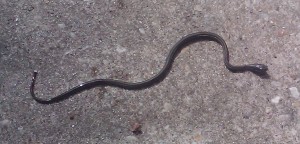I’ve been recently confounded by the “argument from remarkable engineering” fallacy against evolution. It is, quite frankly, only puzzling because it is still in use. The Behe-esque argument was made regarding human development and how remarkably elegant and complicated it was, therefor god. Allow me, for a moment, the chance to slam a lid on embryonic development as an example of remarkable engineering.
If you’re like me and just love learning about embryology beyond the point most people would consider sane, I have a few resources for you. It was brought to my attention-yet again-that I can be a bit masochistic when it comes to learning, so I’ll spare you the long list of “shit that breaks” in the genome. If you’ve ever tried to disassemble a lawnmower engine before you were 10 years old, you might find this wikipedia entry as interesting as I did, but since most people won’t or haven’t, I’ll skip it; it’s also just a list of the disorders and associated mutations. It doesn’t break down all the different types since, honestly, there are dozens of specific mutations for any one disorder and it also leaves out quite a few. I kind of wish it also listed the allelic variations as well, but I can’t have everything, now can I?
How can things go wrong in the development of an embryo? Well, you have 6 basic “types” of errors ranging from the not-so-serious to the abortion-inducing (note: I mean spontaneous abortion, not “have an abortion because it will have three eyes, no legs, and be hermaphroditic”–although that is also possible).
- Polyploidy (extra copies of chromosomes; I include monosomies here, too)
- Mutations (changes in the actual DNA sequence)
- Exposure (to either environmental signals or toxins)
- Unactivated/deactivated pathways (caused by external or internal interference or mutation)
- Overexpression (see explanation of #4)
- Physical trauma (lethal–for the embryo/fetus–oxygen/nutrient deprivation)
To be human is to lack all of the terminating errors and be left only with non-lethal ones. We all have new mutations which our parents did not have; every single one of us has multiple new mutations which could be among any type of mutation: duplications, deletions, frame-shifts, mismatches, etc. Some of us even have trisomies (which are typically lethal) and monosomies (which can be lethal).
The first of these includes Down syndrome (trisomy 21), Trisomy-22, Edwards syndrome (trisomy 18), Patau syndrome (trisomy 13), and pretty much one for every chromosome, although many (including Patau syndrome) result in miscarriage. For survival of the embryo with one of these trisomies which often result in miscarriage requires genetic chimerism where the founder cells are two fertilized ova rather than only one–this can result in non-identical twins or a single chimera. Chimeric individuals can survive with a trisomy which would normally result in death since the other cell line is capable of “filling the gaps” where the trisomy-containing cells could not, such as in many functions of the kidneys or heart or liver (depending upon the trisomy). None of these, I would say, are marvels of engineering.
As mentioned previously, every last one of us has a mutation of some kind, so to say that “human” is a specific genotype with no variation is to miss the point entirely.
[tangent] The “human genome project” was actually an “average human genome project” which did nothing to elucidate the subtleties and complications involved. An example of a complication is the following: hypothetically, an individual can have the mutation for sickle cell anemia, but if another mutation exists (such as an increase in α2γ2 hemoglobin production as opposed to α2β2), then the person develops (almost) normally. Almost because the γ subunit gives a slightly higher oxygen affinity than the β subunit. This is essential due to fetal blood needing to “steal” oxygen from the maternal blood supply.[/tangent]
We are, above all, products of a procedural development, and as new types of cells arise procedurally, they influence the development of additional ones through the same processes of feedback. Procedural development, as a bottom-up process, is inherently unstable and easily broken. How easily? Consider that the removal of a specific single molecule at the beginning of an open reading frame can result in the lack of an entire protein or multiple proteins (if the initial one is a promoter or enhancer or regulatory protein, it could be hundreds). If this (these) protein (s) is/are necessary for survival of that particular cell line or used in a (or many) vital process(es),not all are, then the cell or organism will die. Is this a good design?
The mutations which do arise in all organisms result in evolution, but evolution is, for lack of a better phrase, all about mistakes. These mutations which an organism can live with (and reproduce) are those that rise to higher frequency within the breeding population.
There is an illusion of design resulting from non-lethal mutations being selected AGAINST, not for. Those alleles which confer relative advantage result in decreased success of other alleles in the same population. The previous sentence is VERY important. If a population is isolated, only the alleles present in that population will be subject to any selective pressure unique to that population.
Since mutations arise randomly, and genetic drift “noise” can further complicate the evolutionary history of an organism. The end results of these processes may look, on the outside, to be finely engineered organisms, but the deeper one delves into the anatomy and genetics of an organism, the more of a mess it becomes.




Recent Comments